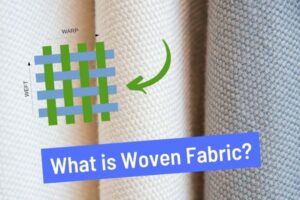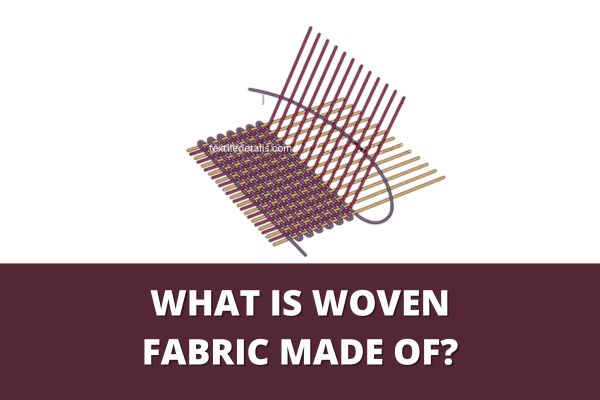Whether you are a newbie in the textile industry, you may hear the term “Woven.” The word “woven fabric” refers to the fabric manufacturing method. It is a popular type of fabric in the textile industry that we frequently use daily.
This article is going to discuss what is woven fabric, along with its properties.
What is Woven Fabric?

Woven fabric is produced by interlacing two or more sets of yarns or threads at right angles to each other. The resulting fabric is created by twisting these yarns, creating a stable and sturdy structure. This fabric can be manufactured from various materials, including cotton, wool, silk, linen, and synthetic fibres.
Woven is produced on a loom. These textiles are created by weaving together two or more pairs of yarn at an angle. In woven textiles, yarns or threads are arranged parallel to each other and linked via a technique known as “warp” and “weft.”
This procedure produces a fabric with a particular texture, properties, authentic look, and other qualities. Fabrics that are woven are often more robust. Woven fabrics are available in different types and have versatile features. Additionally, woven materials are robust, making them ideal for machine cleaning and long-lasting use.
What is woven fabric Made of?

Woven fabrics are made of different types of fibers, including both natural and man-made fibers. To create woven cloth, two or multiple sets of yarns or threads are woven together at the correct angles. Natural fibers like cotton, wool, linen, and silk fiber can be used to manufacture Woven fabric. On the other hand, polyester, nylon, and rayon are some synthetic fibers that can be used to produce this fabric.
Woven fabric Types
Wovens are available in different types, making them versatile. Now I will explore different types of woven fabric with their properties and characteristics:
- Plain Weave Fabric
- Herringbone Weave Fabric
- Twill Fabric
- Pile Weave Fabric
- Satin Fabric
1. Plain Weave Fabric
Plain Weave fabric is the most basic and typical form of woven fabric. The majority of woven textiles are produced with a simple weave. This fabric has the most interconnections and the tightest weave since the weft yarn is woven over and under each warping thread. However, this fabric does have the propensity to wrinkle more quickly.
2. Herringbone Weave Fabric
Chevron patterns woven onto herringbone fabrics make them simple to identify. This gives the material an aesthetic touch that may make a big difference in any environment. Because wool strands are frequently included in the weave, herringbone weave fabric is ideal for cozy upholstery.
3. Twill Fabric
The twill weave is yet another popular type of woven fabric. Weft threads are used to weave this woven fabric up the weft in a diagonal pattern. This method is preferred for fabrics that may experience wear and tear since it increases the textile’s resilience. This fabric is frequently used to make shirts, suits, and sturdy furniture upholstery.
4. Pile Weave Fabric
Pile weaves make use of extra yarns when they are woven into the fabric. They are trimmed to produce a “nap” after standing up to give textiles a more tactile feel. The raised surface created by these extra yarns and threads on woven textiles is known as the nap. Velvet is a common illustration of a woven fabric with a pile weave.
5. Satin Fabric
The look of woven materials with a satin weave is often glossier and shinier. Four or even more weft yarns are passed over a single warp yarn to generate the weave, followed by a minimum of four warp yarns across a single weft yarn. The loosest of all three weave kinds may pull cloth more easily when hooked and snagged.
Read More: Difference Between Plain, Twill, Satin Weave – With 10 Factor
Properties
| Fabric Name | Woven |
| Manufacturing Materials | Natural and Synthetic fibers |
| Fabric Durability | Excellent |
| Fabric Breathability | Depend on Fibers |
| Fabric Texture | Different |
| Fabric stability | Excellent |
| Fabric Drapeability | Variable |
| Fabric Stretchability | Variable |
| Water repellent | Excellent |
| Prone to Bubbling | Low |
| Applications | Clothing, outwear, sportswear, protective textile, and Upholstery |
Characteristics
Woven fabric has several exclusive and impressive characteristics, making it one of the best fabric types in the textile industry. Let’s explore some of the best characteristics of Woven fabrics:
a. Extraordinary Durability
One of the crucial features of woven fabric is its durability. This fabric comes with superior durability and tends to last longer. It can resist several washings, holds its original form, as well as is less prone to stretch out of shape.
b. Breathability and Drapability
It is often breathable, as the interlaced fibers create small gaps or pores that allow air to circulate. This fabric can have varying degrees of drapability or how it hangs or falls. Some fabrics are stiff and hold their shape well, while others are soft and fluid.
c. Coarser texture
It comes with a coarser texture as opposed to being soft. They could also be stiffer and heavier. Because they maintain their form better than knitted textiles, woven fabrics tend to wrinkle and crease more readily, necessitating regular ironing.
d. Excellent Appearance
It can have a variety of appearances, depending on the fiber content, weave pattern, and finishing techniques used. It can range from soft and lightweight to heavy and stiff and can have a smooth or textured surface.
Applications
- Clothing: Men and Women Dresses like pants, shirts, skirts, blouses, and pyjamas.
- Outdoor Clothing: Suits, Raincoats, and Overcoats.
- Sportswear: Sports shoes, Pats, and T-shirts
- Medical textiles: Surgical wear, Staff uniforms, and Operation dresses.
- Filter Products: Microphones, Loudspeakers, and Automotive filter
- Upholstery: Sofa and Chair Cover, Bedding, Headboards, Curtains, and Pelmets
The FAQ’s
Is Cotton a Woven Fabric?
Cotton is a fiber that can be knit as well as woven. It is not in and of itself a woven cloth. Remember that the word “woven” describes how a textile fabric is manufactured, not what is used to make it. Cotton is a fiber utilized to create woven textiles like poplin, gabardine, corduroy, broadcloth, and denim.
What is the woven fabric used for?
Fabrics that are woven are often sturdier. This fabric can be used to make clothes and other items, as well as for covering and adornment. Woven fabrics are also employed in sportswear, medicinal applications, electronics, and the fabrication of airbags in automobile engineering.
What are the benefits of woven fabric?
Woven fabric is the most economical textile for a range of uses. These fabrics can be polished or treated with chemicals to give them properties like breathability and waterproofing. A solid and extensive supply network makes them easily accessible and available.
Conclusion
In conclusion, now you may know what is woven fabric. Instead of knitting the individual strands together, weaving is created by weaving them all together. It is a particular type of fabric with several exclusive characteristics, making it a popular fabric among others. We frequently use this fabric daily since it is pretty convenient. Here I’ve tried to cover everything about Woven fabric that can help you get a clear idea about this fabric.

Very nice article and the website decoration is also good.